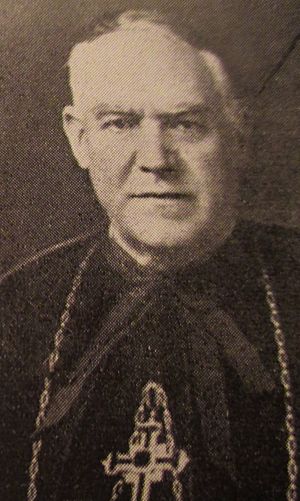Isidro Gomá y Tomás facts for kids
Quick facts for kids Isidro Gomá y Tomás |
|
|---|---|
| Archbishop of Toledo | |
 |
|
| Archdiocese | Toledo |
| See | Toledo |
| Appointed | 12 April 1933 |
| Reign ended | 22 August 1940 |
| Predecessor | Pedro Segura y Sáenz |
| Successor | Enrique Pla y Deniel |
| Other posts | Cardinal-Priest of San Pietro in Montorio (1935–40) |
| Orders | |
| Ordination | 8 June 1895 |
| Consecration | 2 October 1927 by Francisco de Asís Vidal y Barraquer |
| Created Cardinal | 16 December 1935 |
| Rank | Cardinal-Priest |
| Personal details | |
| Birth name | Isidro Gomá y Tomás |
| Born | 19 August 1869 La Riba, Tarragona, Spanish Kingdom |
| Died | 22 August 1940 (aged 71) Toledo, Francoist Spain |
| Buried | Toledo Cathedral |
| Parents | José Tomás Pedrol María Tomás Bosch |
| Previous post |
|
| Alma mater | University of Valencia |
| Motto | Ut Ecclesia aedificationem accipiat |
| Coat of arms |  |
| Styles of Isidro Gomá y Tomás |
|
|---|---|
 |
|
| Reference style | His Eminence |
| Spoken style | Your Eminence |
| Informal style | Cardinal |
| See | Toledo |
Isidro Gomá y Tomás (born August 19, 1869 – died August 22, 1940) was an important leader in the Catholic Church in Spain. He became a bishop, then an Archbishop, and later a Cardinal. He was also known as the Primate of Spain, which means he was the highest-ranking bishop in the country.
Gomá y Tomás was a strong supporter of Francisco Franco and his side, called the National Movement, during the Spanish Civil War (1936-1939). He believed that Spain should be a "Confessional State." This meant he thought the country should officially follow the Roman Catholic religion and that other religions should not be allowed.
After the Spanish Civil War ended, he wrote that the Church had used its influence to help the National Movement win.
Isidro Gomá y Tomás was born in a town called La Riba in Spain. He studied at seminaries in Tarragona and Valencia to become a priest.
Becoming a Priest
Isidro Gomá y Tomás became a priest on June 8, 1895, in Tarragona. For a few years, he worked in churches in the Tarragona area.
From 1897 to 1906, he taught at the Pontifical Seminary of Tarragona. He also served as the rector (the head) of the seminary for some time. He continued to work for the local church until 1927.
Becoming a Bishop
On June 20, 1927, Pope Pius XI chose him to be the bishop of Tarazona. He also took on the role of "apostolic administrator" for Tudela from 1927 to 1933. This meant he helped manage the church in Tudela as well.
Then, on April 12, 1933, he was promoted to a very important position: the Archbishop of Toledo. This made him the Primate of Spain.
Becoming a Cardinal
Isidro Gomá y Tomás was made a Cardinal-Priest by Pope Pius XI on December 16, 1935. This is a very high rank in the Catholic Church.
He continued to strongly support the National Movement during the Spanish Civil War. In 1939, he took part in the meeting where a new Pope was chosen. This meeting is called a conclave, and it was where Pope Pius XII was elected.
Cardinal Gomá y Tomás passed away in 1940. He believed that the war should end with a clear victory for Franco's side, not with a compromise. He thought that all parts of the government that were not Christian should be removed to create a Christian country.
See also
 In Spanish: Isidro Gomá para niños
In Spanish: Isidro Gomá para niños

